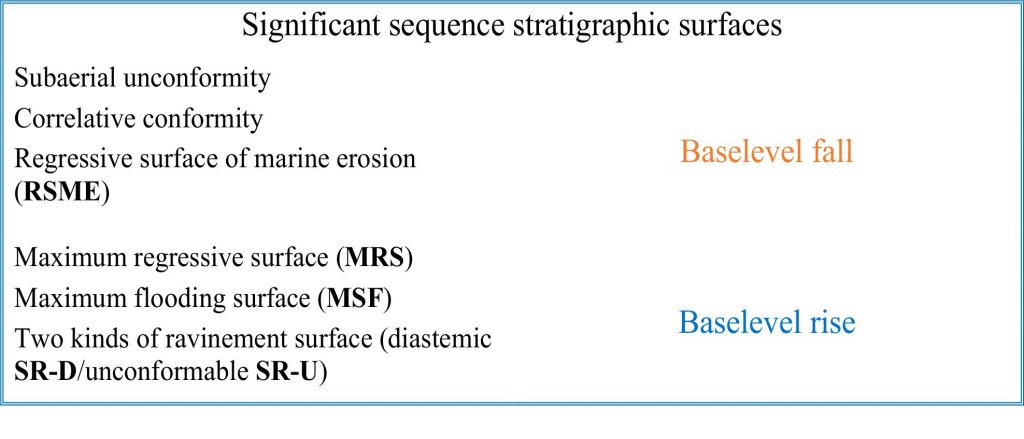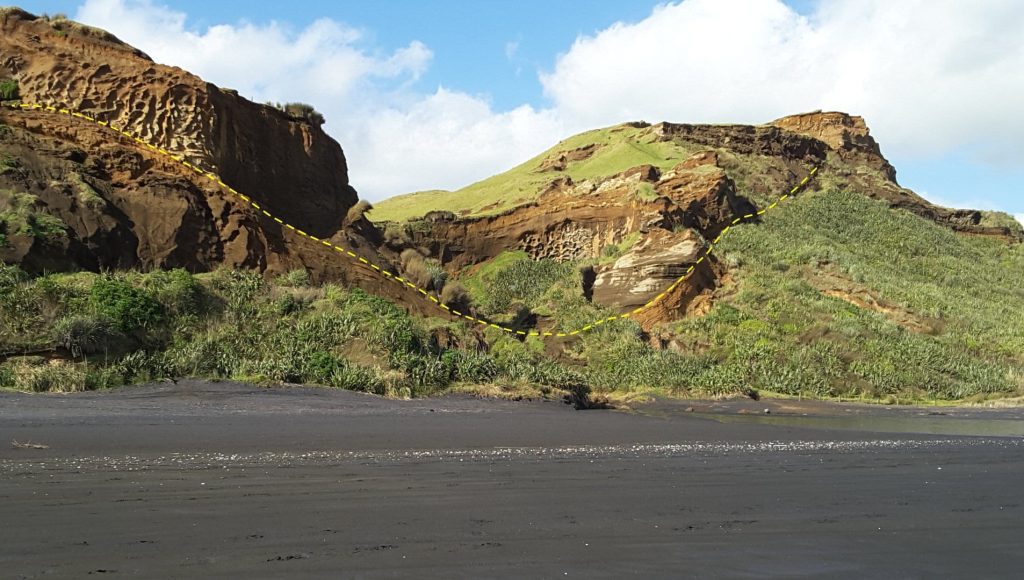

A subaerial unconformity (dashed line) outlines this paleotopographic low where drainage eroded into Pleistocene coastal dunes during falling sea level. The valley was later filled by a younger dune complex as sea level rose and sand on the exposed shelf was moved landward in concert with the migrating shoreline . Kariotahi, New Zealand.
Outcrop expression of subaerial unconformities and regressive surfaces of marine erosion
Six stratigraphic surfaces define the important boundaries of stratigraphic sequences and their system tracts. The significance of these surfaces in sequence stratigraphy is based on a model of baselevel change, a model that, in turn is based on interpretation of facies and stratigraphic trends, experimental studies (e.g., flumes), theoretical considerations, and numerical simulations. The baselevel model dictates that surfaces develop as a function of changes in sediment accommodation and supply, migrating shorelines, and the consequent shifts in environmental conditions.
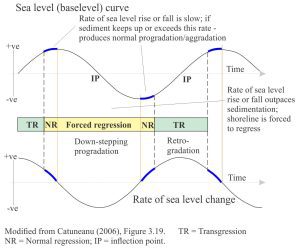

A schematic representation of the baselevel model that makes a bold statement about shoreline trajectories and stratigraphic trends in terms of accommodation space and sediment supply.
The diagnostic criteria for recognition of these surfaces in outcrop and core are based on sedimentary, bio-, and chemical facies and, if the exposure is panoramic, bed geometries such as onlap and offlap.
Five of these surfaces are included here; there are no criteria that ensure definitive identification of correlative conformities in outcrop. These are best identified on seismic profiles where reflections can be traced from the shelf or platform to the deeper basin.
A companion article looks at sequence stratigraphic surfaces formed during baselevel rise.
Several Sverdrup Basin images here and in the companion post on Falling baselevel have been generously donated by Ashton Embry. Some key references are added at the bottom of the page.
Subaerial unconformities
Criteria commonly used to identify subaerial unconformities in outcrop include (some of these also apply to core):
- Evidence of subaerial exposure (e.g., paleosols, regoliths, caliche, karst, and other vadose zone diagenetic features).
- Erosion and truncation of underlying strata.
- Paleotopography.
- Onlap of overlying strata.
- Map extent.
- A significant hiatus (one that has regional or basin-wide extent).
Sverdrup Basin, Arctic Canada


Estuarine deposits, paleosols, blocky regoliths and karst paleotopography (Expedition Fm, Eureka Sound Group) developed on deformed Ordovician to Devonian carbonates and siliciclastics, heralding renewed subsidence and stratigraphic onlap across Sverdrup Basin.
The angular unconformity between Ordovician carbonates and Early Paleocene estuarine mudrocks is underlain by regolith. Fractured limestone is arranged in jig-saw fit patterns; there is no evidence of reworking – shown in the image following. The unconformity is overlain by estuarine mudstone, sandstone and thin coals, and locally tidal channel sandstones. Expedition Fm. Mount Moore, Ellesmere Island.
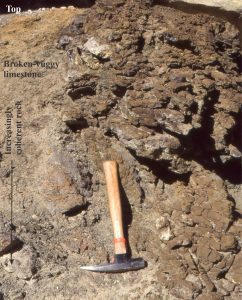

A closer look at the regolith developed on Ordovician limestone. The surfaces of fracture blocks are pitted and embayed by dissolution. Fracturing and dissolution decrease downwards from the upper contact. Elsewhere there is evidence for karstification. Same location as above.
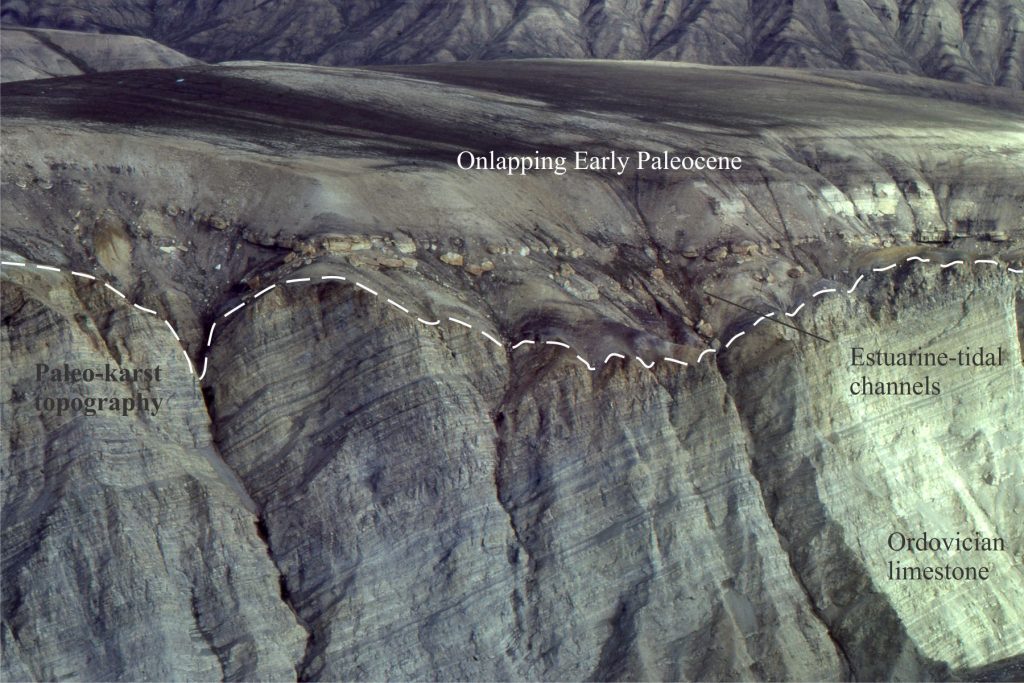

A more expansive view of the Ordovician – Paleocene subaerial unconformity showing the paleotopography developed by karstification during protracted exposure of the Ordovician carbonates (dashed line). The karst surface contains regoliths, dissolution collapse pits, and in places collapse breccias. Lower Paleocene estuarine, tidal channel, sand spit and bar deposits onlap the unconformity from right to left. Same location as above.


The Middle Eocene Buchanan Lake Fm. is a syntectonic conglomerate derived from Mesozoic and Paleozoic rocks carried in the hanging wall of crustal-scale thrusts during the Eurekan Orogeny. The deformation resulted in dismemberment of Sverdrup Basin. The conglomerates were deposited in alluvial fans and more distal fluvial systems. The subaerial unconformity at this locality (Stang Bay) records an abrupt change from Triassic marine sandstone intruded by diabase sills to coarse, diabase-rich conglomerate. Axel Heiberg Island.
Scottish Hebrides


The paleotopographic expression of the unconformity between Late Precambrian Moine schists and Devonian Old Red Sandstone is nicely presented at Portskerra, north Scotland. Basal fluvial deposits that drape the paleotopographic highs overlie remnants of a regolith (see following image), with channel-like crossbedded sandstones filling the topographic lows. The paleo-relief above and below the shore platform is projected to be about 5-10 m.
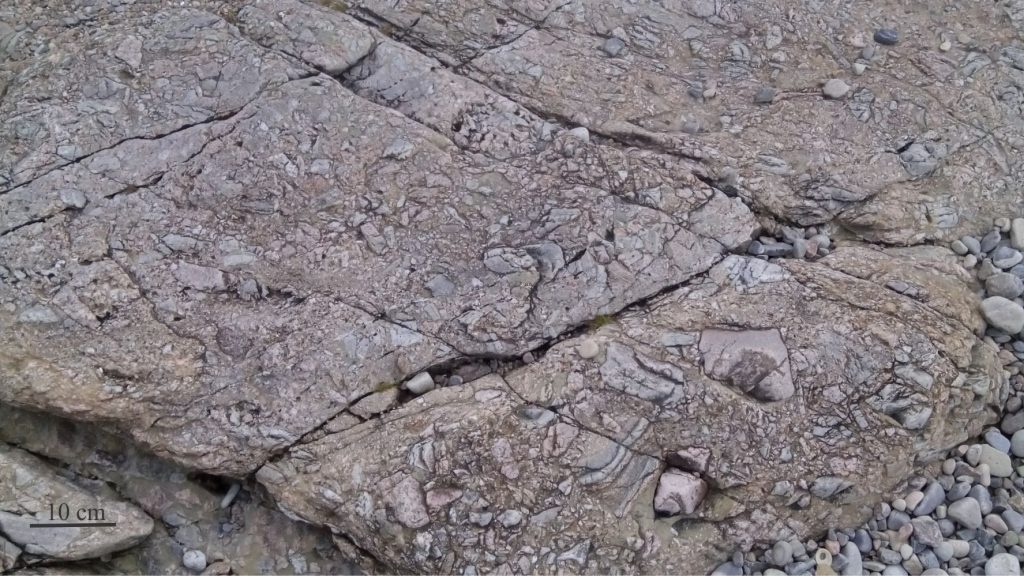

Regolithic breccia at the Moine-Old Red Sandstone unconformity contains broken fragments of schist and pelite. The fragments are mostly angular and unsorted; some are fitted. Interstices between fragments are filled mostly with grit and sand. The regolith is overlain by fluvial sandstone of the Devonian Old Red Sandstone (shown above). Portskerra, north Scotland.
Regressive surface of marine erosion (RSME)
Sverdrup Basin


The examples of RSME surfaces are from the Paleocene Stand Fiord Formation on Axel Heiberg Island (Arctic Canada), part of a third-order sequence. The transition from normal regression (left side, labelled HST) to forced regression is recorded by shelf mudrocks interleaved with abrupt-based, tabular-bedded sandstone units; the base of each sandstone unit is an RSME. The top of each unit is relatively abrupt but conformable. There are four main periods of RSME development that in this view are the packages of resistant beds (labelled 1 to 4); each package may represent a higher-order cyclicity that is superposed on the 3rd order sequence.
In outcrop, the sandstones have blocky profiles (see image below) compared with the more recessive weathering mudstones. Each sandstone unit represents a period of shoreface progradation where sediment supply briefly kept pace with falling baselevel. The overall shoreline trajectory during baselevel fall was gentle seaward downstepping.


An along-strike view of three forced regressive sandstone wedges (package #2 in the image above). The base of each is an abrupt, locally scoured surface of marine erosion (RSME) that overlies discordantly shelf mudrocks, and in turn are overlain conformable by shelf deposits. The sandstones contain planar and trough crossbeds that formed as subaqueous dunes that migrated across a shallow, sandy shoreface-beach. Each sandstone wedge prograded as the shoreline down-stepped seaward during baselevel fall.


A different view of the abrupt erosional base of a forced regressive sandstone wedge (RSME) – this event is part of package #1. The Crossbedded sandstone is underlain by shale and thin bedded fine-grained sandstone.
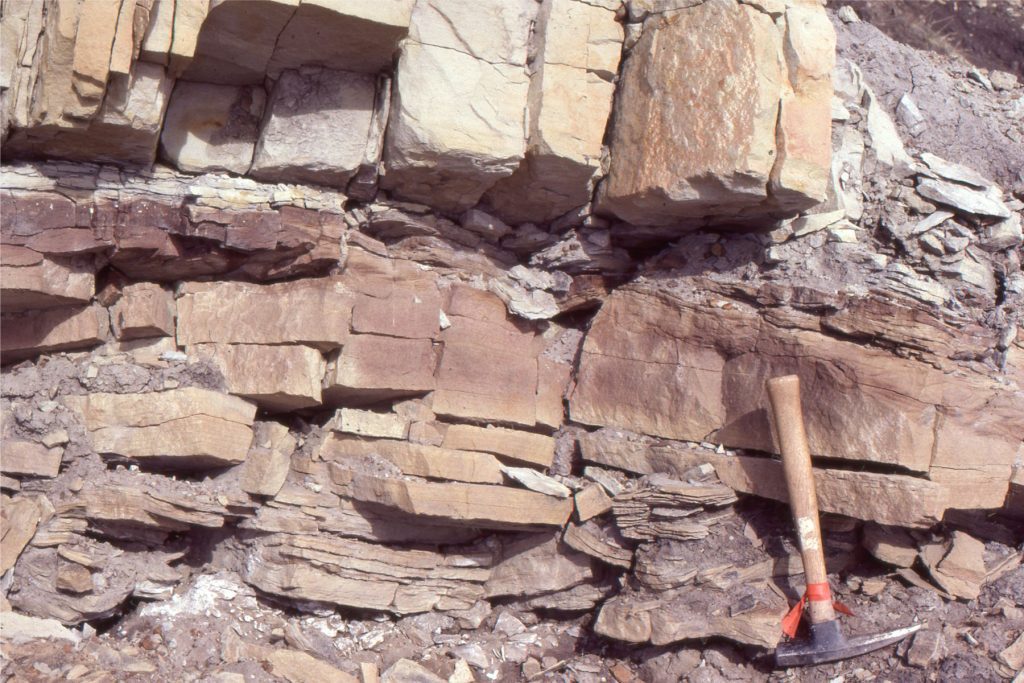

The base of forced regressive sandstone units have shallow scours like this example (at the hammer head) and discordantly overlie grey shale. Sandstones are medium to fine grained and well sorted. The basal sandstone here has shallow trough crossbeds (the lowest unit in package #2).
Some Sverdrup Basin sequence stratigraphy papers
Embry, A.F. 2011. Petroleum prospectivity of the Triassic–Jurassic succession of Sverdrup Basin, Canadian Arctic Archipelago. In Chapter 36, Spencer, A. M., Embry, A. F., Gautier, D. L., Stoupakova, A. V. & Sørensen, K. (eds) Arctic Petroleum Geology. Geological Society, London, Memoirs, 35, p. 545–558.
Embry, A.F., and Johannessen, E.P. 2017 Two Approaches to Sequence Stratigraphy. In; Chapter 27, Stratigraphy & Timescales, Volume 2, Elsevier. PDF available
Embry, A.F. 2018. Triassic history of the Tanquary High in NE Sverdrup Basin, Canadian Arctic Archipelago. In; Piepjohn, K., Strauss, J.V., Reinhardt, L., and McClelland, W.C., eds., Circum-Arctic Structural Events: Tectonic Evolution of the Arctic Margins and Trans-Arctic Links with Adjacent Orogens. The Geological Society of America Special Paper 541, p. 285–301.
Embry, A., and B. Beauchamp. 2019. Chapter 14. Sverdrup Basin. In; A.D. Miall, (Ed.), The Sedimentary Basins of the United States and Canada, Elsevier, p.559-592.
Ricketts, B.D. and Stephenson, R.A. 1994. The demise of Sverdrup Basin: Late Cretaceous – Paleogene sequence stratigraphy and forward modelling. Journal of Sedimentary Research (1994) 64 (4b): 516–530.
Other posts in this ‘outcrop’ series
Sedimentary structures: Shallow marine
Sedimentary structures: Turbidites
Sedimentary structures: Mass transport deposits
Sedimentary structures: Fine-grained fluvial
Sedimentary structures: coarse-grained fluvial
Sedimentary structures: Alluvial fans
Sedimentary structures: Stromatolites
Volcanics in outcrop: Lava flows
Volcanics in outcrop: Secondary volcaniclastics
Volcanics in outcrop: Pyroclastic fall deposits
Volcanics in outcrop: Pyroclastic density currents
Ignimbrites in outcrop and thin section
Accretionary aggregates and accretionary lapilli

